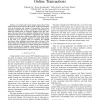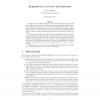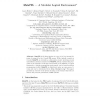1401 search results - page 149 / 281 » Randomness in Interactive Proofs |
SECURWARE
2008
IEEE
15 years 4 months ago
2008
IEEE
— In current peer-to-peer systems users interact with unknown services and users for the purpose of online transactions such as file sharing and trading of commodities. Peer-to-...
BIRTHDAY
2005
Springer
15 years 3 months ago
2005
Springer
Expander2 is a flexible multi-purpose workbench for interactive rewriting, verification, constraint solving, flow graph analysis and other procedures that build up proofs or co...
TPHOL
2003
IEEE
15 years 3 months ago
2003
IEEE
MetaPRL is the latest system to come out of over twenty five years of research by the Cornell PRL group. While initially created at Cornell, MetaPRL is currently a collaborative p...
101
click to vote
CCS
2003
ACM
15 years 3 months ago
2003
ACM
This paper continues the program initiated in [5], towards a derivation system for security protocols. The general idea is that complex protocols can be formally derived, starting...
SP
1998
IEEE
15 years 2 months ago
1998
IEEE
A strand is a sequence of events; it represents either the execution of legitimate party in a security protocol or else a sequence of actions by a penetrator. A strand space is a ...



